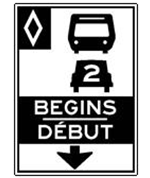[searchform]
High Vehicle Occupancy Lanes
About
 Highway Traffic Act section 154.1 (1)
Highway Traffic Act section 154.1 (1)
Where a part of a highway has been divided into clearly marked lanes of traffic, the government may designate any lane as a high occupancy vehicle lane.
The government can limit the use for:
- days, months, times of day,
- conditions or circumstances
- the types of vehicles and number of occupants
* this charge under the Highway Traffic Act refers only to Ontario highways, e.g. Hwy 401, 416, 402, 404, 400. The charge does not apply to roadways within a municipality.
Most high occupancy lanes have the restriction that that vehicle must have 2 or more passengers in the vehicle.
The regulations regarding High Vehicle Occupancy Lanes is within Ontario Regulation 620/05.
Exempt Vehicles
The following vehicles are exempt from the regulations for High Vehicle Occupancy Lanes:
- buses
- emergency vehicles, police, fire and ambulances
- Province of Ontario vehicles,
- while in performance of duties
- construction vehicles,
- while working at or near the lane
- tow trucks who have been called by
- police or person with disabled vehicle
- vehicles with valid number plates that,
- are issued by the Ministry
- have green letter on white background
- display the words “GREEN VEHICLE”
Related Charges:
Insurance Implications
A conviction on the drivers abstract for driving in a high occupancy lane can affect insurance rates.
Once the driver is convicted of a traffic ticket, the court sends a notice to the Ministry of Transportation.
Upon receiving the record of conviction, the Ministry of Transportation adds the court conviction to the driving record.
Driving Records/Abstracts
Driving abstracts are available to anyone who has the drivers licence number for a fee payable to the Ministry of Transportation.
Therefore the way the insurance company will finds out about the ticket is;
- The insurance company contacts
- the Ministry of Transportation and
- checks the drivers abstract, or
- the driver calls and
- tells the insurance company that they received a ticket
Each insurance company is a private company with their own set of rules and standards.
Some insurance companies will not increase insurance rates for one ticket and others will. The problem is drivers don’t know what the insurance company is going to do, and if asked, there is a chance they will increase it due to the inquiry.
Drivers need to keep their driving records clear.
Fines
The fine for driving in a high occupancy lane is $110.00.
Summons to Appear in Court
Where a police officer issues a summons to appear or the driver disputes the ticket, the Justice of the Peace (JP) can increase the fine up to $500.00. This rarely happens for this offence but it is possible.
The out of court fine is actually, $90.00 but the court adds a $20.00 Victim Fine Surcharge to the ticket.
What is the Victim Fine Surcharge?
- The provincial government adds a victim fine surcharge (VFS) to every non-parking fine imposed under the Provincial Offences Act.
- It is deposited into a special fund to help victims of crime.
- The amount of the VFS is usually 20 per cent of the imposed fine.
- For example, a $100 fine would result in a $20 surcharge.
- Fines over $1,000 carry a surcharge of 25 per cent.
Penalties
A conviction for driving in a high occupancy lane has the following penalties:
- out of court fine of $110.00
- maximum fine of $500.00
- conviction appears on driving abstract for 3 years
- can affect insurance rates
- 3 demerit points
Demerit Points
Driving in a high occupancy lane tickets have 3 demerit points.
- G1 drivers are suspended for
- any 4 ticket with 4 demerit points
- accumulating 6 demerit points
- G2 drivers are suspended for
- any 4 ticket with 4 demerit points
- accumulating 6 demerit points
- G drivers are suspended for
- accumulating 15 demerit points
- at 8 points class G drivers may be required to attend a Demerit Point Interview
Demerit Point Interviews
If you have to attend an interview, you will get a letter (Notice of Interview) to notify you of the time, date and location of the meeting. If you do not attend your licence could be suspended.
The fee for a demerit point interview is $50 and must be paid in person at any Service Ontario Centre.
You can pay the fee when you receive the Notice of Interview or within 10 business days of attending the interview.
Failure to pay the interview fee will result in the cancellation of your driver’s licence.
Suspensions
Drivers are not suspended for a conviction for driving in a high occupancy lane.
Novice Drivers
Class G1 and Class G2 drivers are suspended for 30 days for violating the demerit point restrictions for novice drivers
Unpaid Fines
Any driver maybe suspended where any fine goes into default. Where the licence is suspended for an unpaid fine, the licence will be suspended until the payment is made to the court.
Demerit Point Suspensions
The accumulation of demerit points can result in a licence suspension.
- Class G1 and G2 drivers are suspended for accumulating 6 demerit points
- Class G1 and G2 drivers are suspended for any one ticket with 4 demerit points
- e.g. careless driving, following too close, speeding more than 30km/h
- Class G licences receive a drivers licence interview at 8 points
- Class G licences are suspended at 15 demerits
Legal Definition
Regulations for high occupancy vehicle lanes
154.1 (1) Where a part of the King’s Highway has been divided into clearly marked lanes for traffic, the Minister may by regulation designate any lane as a high occupancy vehicle lane for that part of the King’s Highway and may make regulations,
(a) limiting the designation to specified months or times of the year, days, times, conditions or circumstances;
(b) limiting the use of high occupancy vehicle lanes to vehicles, or any class or type of vehicles, with a specified number of occupants, and prescribing conditions and circumstances for such use;
(c) regulating the use of high occupancy vehicle lanes, including prescribing rules of the road applicable to the use of the lanes, exemptions from any requirement in this Part or in a regulation made under this Part applicable to the use of the lanes and conditions and circumstances for such exemptions;
(d) providing for the erection of signs and the placing of markings to identify high occupancy vehicle lanes and the entry and exit points for high occupancy vehicle lanes;
(d.1) providing for the posting of signs on any part of a highway designated as having a high occupancy vehicle lane that is in a construction zone designated under subsection 128 (8);
(e) prescribing the types of the signs and markings referred to in clause (d), instructions to be contained on them and the location of each type of sign and marking.
Construction zone
(1.1) Where a construction zone designated under subsection 128 (8) includes a high occupancy vehicle lane or part of a high occupancy vehicle lane designated under subsection (1), the official authorized under subsection 128 (8) may authorize a temporary change of the commencement or end of the part of the high occupancy vehicle lane that is within the designated construction zone, and any such change shall not become effective until the highway or portion of it affected is signed in accordance with the regulations.
Regulation may be general or specific
(2) A regulation made under subsection (1) may be general or specific in its application and may apply differently to different classes or types of vehicles.
Offence
(3) No person shall drive a motor vehicle in a high occupancy vehicle lane or enter or exit a high occupancy vehicle lane except in accordance with this section and the regulations made under it.
Ontario Regulation 620/05 HIGH OCCUPANCY VEHICLE LANES
Designation of high occupancy vehicle lanes
1. The left lane of the part of the King’s Highway described in a schedule to this Regulation is designated as a high occupancy vehicle lane for the hours, days and months specified in the schedule.
Use of high occupancy vehicle lanes
2. (1) No person shall operate a motor vehicle in a high occupancy vehicle lane unless the vehicle has at least two persons occupying seating positions.
(2) No person shall operate a commercial motor vehicle in a high occupancy vehicle lane unless,
(a) the vehicle has at least two persons occupying seating positions; and
(b) the length of the vehicle or the total length of the vehicle and any vehicle being towed by it is less than 6.5 metres. O. Reg. 188/16, s. 1.
(3) Despite subsections (1) and (2), a person may operate a motor vehicle in a high occupancy vehicle lane with only one person occupying a seating position if the requirements of one of the following paragraphs are satisfied:
1. The vehicle is a bus.
2. The person is operating an emergency vehicle, as defined in section 144 of the Act, in the performance of his or her duties.
3. The person is operating the vehicle in the lawful performance of his or her duties as a police officer.
4. The person is operating a vehicle owned or leased by the Province of Ontario in the lawful performance of his or her duties as an officer appointed for carrying out the provisions of the Act.
5. The person is operating a vehicle engaged in road construction or maintenance activities in or near the high occupancy vehicle lane.
6. The person is operating a tow truck that has been requested to provide towing or repair services to a disabled vehicle in or near a high occupancy vehicle lane by a police officer, an officer appointed for carrying out the provisions of the Act or a person driving the disabled vehicle, and operating the tow truck in the high occupancy vehicle lane is necessary to attend at and depart from the location of the disabled vehicle.
7. The person is operating a motor vehicle to which are attached valid number plates that,
i. are issued by the Ministry,
ii. have green lettering on a white background, and
iii. display the words “GREEN VEHICLE” or “VÉHICULE ÉCOLOGIQUE”.
8. The vehicle is a taxicab or limousine that,
i. is being operated by a person who has a valid licence, permit or authorization issued by a municipality or airport authority to operate the vehicle for the purpose of providing passenger transportation services, and
ii. has mounted on the rear of the vehicle a valid plate bearing an identification number issued by the municipality or airport authority for the use of the vehicle for that purpose.
9. The vehicle is a motorcycle.
Case Law
Here is no applicable case law for this charge as of the date of writing. Please review the CanLi site for any updates.


